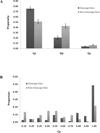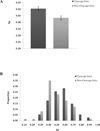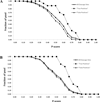A multi-factor model for caspase degradome prediction
- PMID: 19958504
- PMCID: PMC2788393
- DOI: 10.1186/1471-2164-10-S3-S6
A multi-factor model for caspase degradome prediction
Abstract
Background: Caspases belong to a class of cysteine proteases which function as critical effectors in cellular processes such as apoptosis and inflammation by cleaving substrates immediately after unique tetrapeptide sites. With hundreds of reported substrates and many more expected to be discovered, the elucidation of the caspase degradome will be an important milestone in the study of these proteases in human health and disease. Several computational methods for predicting caspase cleavage sites have been developed recently for identifying potential substrates. However, as most of these methods are based primarily on the detection of the tetrapeptide cleavage sites - a factor necessary but not sufficient for predicting in vivo substrate cleavage - prediction outcomes will inevitably include many false positives.
Results: In this paper, we show that structural factors such as the presence of disorder and solvent exposure in the vicinity of the cleavage site are important and can be used to enhance results from cleavage site prediction. We constructed a two-step model incorporating cleavage site prediction and these factors to predict caspase substrates. Sequences are first predicted for cleavage sites using CASVM or GraBCas. Predicted cleavage sites are then scored, ranked and filtered against a cut-off based on their propensities for locating in disordered and solvent exposed regions. Using an independent dataset of caspase substrates, the model was shown to achieve greater positive predictive values compared to CASVM or GraBCas alone, and was able to reduce the false positives pool by up to 13% and 53% respectively while retaining all true positives. We applied our prediction model on the family of receptor tyrosine kinases (RTKs) and highlighted several members as potential caspase targets. The results suggest that RTKs may be generally regulated by caspase cleavage and in some cases, promote the induction of apoptotic cell death - a function distinct from their role as transducers of survival and growth signals.
Conclusion: As a step towards the prediction of in vivo caspase substrates, we have developed an accurate method incorporating cleavage site prediction and structural factors. The multi-factor model augments existing methods and complements experimental efforts to define the caspase degradome on the systems-wide basis.
Figures





Similar articles
-
iProt-Sub: a comprehensive package for accurately mapping and predicting protease-specific substrates and cleavage sites.Brief Bioinform. 2019 Mar 25;20(2):638-658. doi: 10.1093/bib/bby028. Brief Bioinform. 2019. PMID: 29897410 Free PMC article. Review.
-
Pripper: prediction of caspase cleavage sites from whole proteomes.BMC Bioinformatics. 2010 Jun 15;11:320. doi: 10.1186/1471-2105-11-320. BMC Bioinformatics. 2010. PMID: 20546630 Free PMC article.
-
SVM-based prediction of caspase substrate cleavage sites.BMC Bioinformatics. 2006 Dec 18;7 Suppl 5(Suppl 5):S14. doi: 10.1186/1471-2105-7-S5-S14. BMC Bioinformatics. 2006. PMID: 17254298 Free PMC article.
-
CASVM: web server for SVM-based prediction of caspase substrates cleavage sites.Bioinformatics. 2007 Dec 1;23(23):3241-3. doi: 10.1093/bioinformatics/btm334. Epub 2007 Jun 28. Bioinformatics. 2007. PMID: 17599937
-
The CASBAH: a searchable database of caspase substrates.Cell Death Differ. 2007 Apr;14(4):641-50. doi: 10.1038/sj.cdd.4402103. Epub 2007 Feb 2. Cell Death Differ. 2007. PMID: 17273173 Review.
Cited by
-
PROSPER: an integrated feature-based tool for predicting protease substrate cleavage sites.PLoS One. 2012;7(11):e50300. doi: 10.1371/journal.pone.0050300. Epub 2012 Nov 29. PLoS One. 2012. PMID: 23209700 Free PMC article.
-
Extending Asia Pacific bioinformatics into new realms in the "-omics" era.BMC Genomics. 2009 Dec 3;10 Suppl 3(Suppl 3):S1. doi: 10.1186/1471-2164-10-S3-S1. BMC Genomics. 2009. PMID: 19958472 Free PMC article.
-
iProt-Sub: a comprehensive package for accurately mapping and predicting protease-specific substrates and cleavage sites.Brief Bioinform. 2019 Mar 25;20(2):638-658. doi: 10.1093/bib/bby028. Brief Bioinform. 2019. PMID: 29897410 Free PMC article. Review.
-
Pripper: prediction of caspase cleavage sites from whole proteomes.BMC Bioinformatics. 2010 Jun 15;11:320. doi: 10.1186/1471-2105-11-320. BMC Bioinformatics. 2010. PMID: 20546630 Free PMC article.
-
Toward more accurate prediction of caspase cleavage sites: a comprehensive review of current methods, tools and features.Brief Bioinform. 2019 Sep 27;20(5):1669-1684. doi: 10.1093/bib/bby041. Brief Bioinform. 2019. PMID: 29860277 Free PMC article.
References
-
- Thornberry NA, Rano TA, Peterson EP, Rasper DM, Timkey T, Garcia-Calvo M, Houtzager VM, Nordstrom PA, Roy S, Vaillancourt JP, Chapman KT, Nicholson DW. A combinatorial approach defines specificities of members of the caspase family and granzyme B. Functional relationships established for key mediators of apoptosis. J Biol Chem. 1997;272:17907–11. doi: 10.1074/jbc.272.29.17907. - DOI - PubMed
Publication types
MeSH terms
Substances
LinkOut - more resources
Full Text Sources
Research Materials

